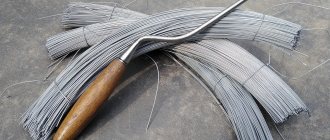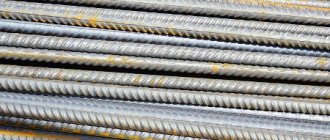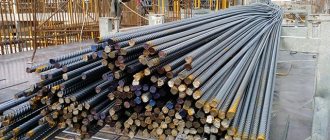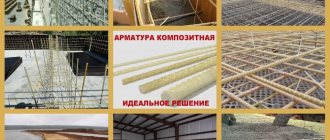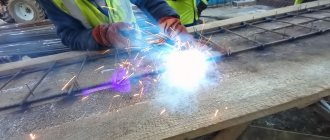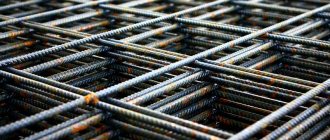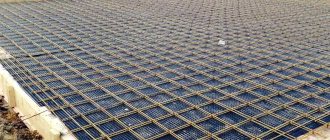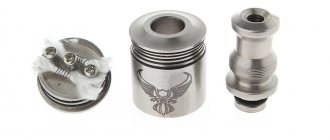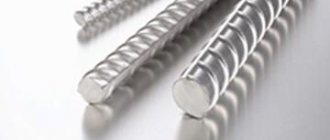In the total cost of construction, a significant portion falls on the reinforcement of reinforced concrete structures. In retail sales, the price is per linear meter. However, when constructing a foundation, a large amount of reinforcement is required, so it is cheaper to purchase it at wholesale stores. And the wholesale price is indicated in rubles/ton of products. This means that linear meters must somehow be converted into tons.
State standards indicate the weight of one linear meter of reinforcement of a specific diameter. To calculate the required kilograms or tons, you need to multiply the weight of one meter by the total length of all rods of the same diameter. By weight, by the way, the percentage of reinforcement of a reinforced concrete structure is also determined (the ratio of the mass of metal and the volume of concrete).
Reinforcement for slab foundations
A slab foundation is used where it is necessary to install a heavy house made of concrete or brick with large reinforced concrete floors on heaving soil. In this case, the foundation requires reinforcement. It is produced in two belts, each of which consists of two layers of rods located perpendicular to each other. Let's consider the option of calculating reinforcement for a slab whose side length is 5 meters. Reinforcing bars are placed at a distance of about 20 cm from each other. Therefore, one side will require 25 rods. The rods are not placed at the edges of the slab, which means there are 23 left. Now, knowing the number of rods, you can calculate their length. Here it should be noted that the reinforcement rods should not reach the edge of 20 cm, and, therefore, based on the length of the slab, the length of each rod will be 460 cm. The transverse layer, provided that the slab has a square shape, will be the same. We also need to calculate the amount of reinforcement required to connect both chords. Let's assume that the distance between the belts is 23 cm. In this case, one jumper between them will have a length of 25 cm, since another two centimeters will be spent on fastening the reinforcement. In our case, there will be 23 such jumpers in a row, since they are made in each cell at the intersection of the reinforcement belts. Having this data, we can begin to calculate using the program.
How to use the table
The table shows:
- Reinforcement diameter
- Sectional area of the rod
- Weight of one linear meter
- Steel grade
First, in the “diameter of reinforcement” column, you find the product with which you are going to reinforce the structure, then, moving along the horizontal line of the table, you look for the weight of a linear meter.
Table - weight per linear meter of reinforcement
Reinforcement for strip foundation
A strip foundation is used where a heavy house is supposed to be built on not very stable soil. This foundation is a ribbon of concrete or reinforced concrete that stretches along the entire perimeter of the building and under the main load-bearing walls. Reinforcement of such a foundation is also made in 2 belts, but due to the specifics of a strip foundation, much less reinforcement is consumed, and, therefore, it will cost less. The rules for laying out reinforcement are approximately the same as for a slab foundation. Only the rods should end already 30-40 cm from the corner. And each jumper should protrude 2-4 cm beyond the rod on which it lies. The calculation of vertical lintels is carried out according to the same principle as when calculating the required length of reinforcement for a slab foundation. Please note that in both the first and second cases, the reinforcement must be taken with a margin of at least 2-5 percent.
How to calculate the mass of reinforcement yourself?
The formula for calculating the mass of a reinforcement bar is as follows:
π
– Pi number
D
– reinforcement diameter, mm
ρ
– steel density, (7850 kg/m3)
L
– rod length, m
Armature
are elements connected to each other, used in reinforced concrete products to maintain tensile stress or as reinforcement of concrete in compression.
Reinforcement and reinforcing mesh are used during construction work, during the construction of foundations and wall structures, using monolithic concrete. To carry out concrete work, it is necessary to spend a lot of time constructing a reinforcement frame. To do this, the structure is reinforced using reinforcing mesh.
To calculate the order volume, it is necessary to determine the weight of the reinforcement and determine the number of linear meters. Note that it is indicated in the GOST table given above on the page. Here you will find all the necessary values. It is also worth considering that the weight of the reinforcement is set based on the calculation of the diameter and area of operation of the periodic profile.
Like reference tables, the rebar calculator calculates the theoretical weight of the product. GOST allows deviations of the geometric dimensions of the product from the nominal ones. You can find out the actual weight by weighing reinforcement of a certain length. Accurate information about the weight and other characteristics of the fittings is indicated in the product passport from the manufacturer.
a ton of reinforcement, how many meters is that? | TABLE
1 ton of reinforcement can be from 25 to 10101 meters. It all depends on the diameter of the reinforcing bar. A linear meter of reinforcement is individual reinforcing bars of a smooth and periodic profile 1 meter long, the weight of which depends on the diameter of the reinforcing steel GOST 5781-82 (from a range of diameter sizes of periodic steel - 6, 8.10, 12, 14, 16, 18.20, 22, 25, 28, 32, 36, 40, 45, 50, 55, 60, 70, 80 mm).
| Reinforcement size (nominal bar diameter) | Weight of 1 m of reinforcement in kilograms | Number of meters of reinforcement in 1 ton |
| 4 | 0,099 | 10101,010 |
| 5 | 0,154 | 6493,506 |
| 6 | 0,222 | 4504,504 |
| 8 | 0,395 | 2531,645 |
| 10 | 0,617 | 1620,745 |
| 12 | 0,888 | 1126,126 |
| 14 | 1,210 | 826,446 |
| 16 | 1,580 | 632,911 |
| 18 | 2,000 | 500,000 |
| 20 | 2,470 | 404,858 |
| 22 | 2,980 | 335,570 |
| 25 | 3,850 | 259,740 |
| 28 | 4,830 | 207,037 |
| 32 | 6,310 | 158,478 |
| 36 | 7,990 | 125,156 |
| 40 | 9,870 | 101,317 |
| 45 | 12,480 | 80,128 |
| 50 | 15,410 | 64,892 |
| 55 | 18,650 | 53,619 |
| 60 | 22,190 | 45,065 |
| 70 | 30,210 | 33,101 |
| 80 | 39,460 | 25,342 |
Judging by this table, 1126 meters of reinforcement with a diameter of 12 mm equals one ton of product.
Using this table you can also find out the length of the reinforcement in one kilogram and its weight in one meter of all sizes.
These values will be useful to you when using a metal rod directly if, for example, you need to know what the mass of all the reinforcement used in the construction of a building is. To do this, you just need to add up all the lengths of the reinforcing bars and then multiply the sum by the weight of 1 p/m.
It should be noted that reinforcement still exists and is used when pouring foundations. But this occurs only in transverse, that is, in auxiliary reinforcement. In addition to these factors, we should not forget that only those rods that are marked with the symbol “C” are subject to welding.
This whole long process is necessary, since during construction it is necessary to know the length of the material, and when purchasing it, mass (weight) is important.
Diameters of fittings according to GOST 5781-82
Do not forget that the number of rods per ton can vary, because this directly depends on their length. For example, much fewer rods 10 meters long will be needed than rods with the same diameter but 2 m long.
Sources:
https://domstrousam.ru/skolko-metrov-armaturyi-v-tonne-tablitsa-vseh-razmerov-i-massa/
Characteristics
In the production of these products, St3 of various degrees of deoxidation is used - boiling, semi-calm, calm. Products made from completely deoxidized steel (calm) are used in critical structures designed to withstand high loads. Rolled products can be heat-strengthened (T) or stretch-strengthened (B).
Main physical characteristics:
- yield strength – 235 N/mm2;
- temporary tensile strength – 373 N/mm2;
- relative elongation – no less than 25%.
Performance properties of steel reinforcement A1 (A240):
Good weldability due to low carbon steel construction.- Environmental friendliness. These products have safety certificates indicating their compliance with regulatory requirements.
- Possibility of bending at the angle necessary to create a structure.
- Low resistance to corrosion. Increased by painting, galvanizing, aluminum zinc plating.
- Lower cost compared to periodic profile reinforcement.
Pouring a concrete foundation
To fill the foundation, you must use special reinforcement. But it is not so easy to choose. How to buy high-quality reinforcement for the foundation so that it is suitable specifically for your home and does not cost too much? After all, it is important to know whether you need to purchase rods with a periodic profile, or take smooth ones and save money.
Our company’s specialists will be happy to calculate the required amount of material and advise what rod diameter is needed in your case. They will also ensure that the strength class and operational features fully satisfy your needs.
Information on the purpose of the calculator
Online calculator for monolithic strip foundation
designed for calculating dimensions, formwork, quantity and diameter of reinforcement and volume of concrete required for the construction of this type of foundation. To determine the appropriate type of foundation, be sure to contact a specialist.
All calculations are performed in accordance with SNiP 52-01-2003 “Concrete and reinforced concrete structures”, SNiP 3.03.01-87 and GOST R 52086-2003
A strip foundation is a monolithic closed reinforced concrete strip running under each load-bearing wall of a building, thereby distributing the load along the entire length of the strip. Prevents subsidence and changes in the shape of the building due to the action of soil heaving forces. The main loads are concentrated at the corners. It is the most popular type among other foundations in the construction of private houses, as it has the best ratio of cost and necessary characteristics.
There are several types of strip foundations, such as monolithic and prefabricated, shallow and deep. The choice depends on the characteristics of the soil, the expected load and other parameters that must be considered in each case individually. Suitable for almost all types of buildings and can be used when constructing basements and basements.
The design of the foundation must be carried out especially carefully, since if it is deformed, this will affect the entire structure, and correcting errors is a very complex and expensive procedure.
When filling out the data, pay attention to the additional information with the Additional information sign
The following is a complete list of calculations performed with a brief description of each item.
If you don't have a table at hand
Not everyone has the necessary GOST, but each of us studied at school. To independently calculate the weight of a linear meter, basic knowledge of mathematics and physics is sufficient. Everyone knows that mass is equal to the volume of a body multiplied by the specific gravity of the material. The volume is calculated using the formula:
V = F x L, where
- V – body volume, m3
- F – its cross-sectional area, m2
- L – body length, m
The cross section of the reinforcement is a circle. Its area is easy to calculate, knowing the diameter of the rod:
F = 3.14 x D2/ 4 = 0.785 x D2, where
- D – reinforcement diameter (in meters)
- 3.14 – the well-known constant value π (it is dimensionless)
As you can see, calculating the cross-sectional area and volume of the rod is not difficult. Now you can calculate the weight of a linear meter. This is also done simply, using the formula:
M = V xp, where
- p – specific gravity of steel. It is equal to 7850 kg/m3.
There is some inaccuracy in these calculations: the reinforcement is not a smooth rod, and we do not take into account the dimensions of the corrugations. But if you calculate the weight of a meter rod in this way and compare it with the tabular data, you will see that your result is not much different from them.
Calculation examples
As examples, let us consider calculating the weight of a linear meter of reinforcement with the most common diameters of 6 mm and 12 mm of class A III. This material has a periodic profile (longitudinal ribs and transverse protrusions are applied to its forming surface). Special steel is used to manufacture A3 reinforcement. Thanks to the complex surface, metal and concrete form a single monolith.
Reinforcement with a diameter of 6 and 12 mm is used in the construction of dachas, private houses - for reinforcing strip foundations.
- Let's calculate the weight of a linear meter of reinforcement A3 with a diameter of 6 mm: Sectional area F = 3.14 x 0.006 x 0.006/ 4 = 0.000028 m2
- Volume per linear meter V = 0.000028 m2 x 1m = 0.000028 m3
- Weight M = 0.000028 m3 x 7850 kg/m3 = 0.221 kg
- Let's calculate the weight of a linear meter of reinforcement with a diameter of 12 mm: Sectional area F = 3.14 x 0.012 x 0.012/ 4 = 0.000113 m2
- Volume per linear meter V = 0.000113 m2 x 1 m = 0.000113 m3
- Weight M = 0.000113 m3 x 7850 kg/m3 = 0.887 kg
According to the GOST table, weight is 1 linear. m of reinforcement 6 is 0.222 kg, reinforcement 12 is 0.888 kg. As you can see, the discrepancy in numbers is small. It must be admitted, however, that the data presented in the table also does not claim to be highly accurate. They were also calculated theoretically.
In fact, the actual weight of a linear meter may differ from the table by 0.2 - 3%, both plus and minus.
How to calculate the amount of reinforcement for an object
Foundation reinforcement scheme
Do-it-yourself calculations are not so difficult if the construction project is small, for example, a slab foundation of a house 8 * 8 m. The algorithm is as follows.
- From the reference book they learn that such a building requires a slab foundation with a depth of 30 cm and reinforcing rods with a diameter of 14 mm.
- The width of the base is divided into conventional cells of 20 cm, that is, 8/0.2, and a number of 40 rods is obtained. The number of transverse elements is calculated in the same way. Since the second side is also left 8 m, the number of reinforcing rods is the same - 40. The total number of rods is 80.
- Laying in concrete 30 cm thick requires 2 grids or 2 belts - upper and lower. Accordingly, the value needs to be doubled - 160 rods.
- Reinforcement is offered not in pieces, but in tons or linear meters . Therefore, the total length of the reinforcement is found using the simplest formula: 160 * 8 = 1280 m. However, it must be taken into account that at the ends and in sections it will be necessary to install U-shaped clamps and connect the upper and lower chords with additional rods. Therefore, the resulting value is increased by 2–3%. They get 1305.6 meters.
If necessary, the indicator is converted to tons. The weight of 1 linear meter of a rod with a diameter of 14 mm is 1.21 kg. When multiplied, the weight is 1.58 tons.
Footage of reinforcement in ton: calculation example, table
Let's look at an example of how the calculation is made and find out how many meters of reinforcement with a diameter of 12 mm are in 1 ton.
To calculate, we need to know the mass of 1 meter, look at the table of the weight of the reinforcement, it is equal to 0.888 kg. Now we divide 1000 kg by 0.888 kg, we get 1126.13 m. For convenience, below is a table that immediately indicates the footage of the most popular steel rods in construction.
| Rod diameter, mm. | Number of meters in 1 ton |
| 6 | 4504,5 |
| 8 | 2531,65 |
| 10 | 1620,75 |
| 12 | 1126,13 |
| 14 | 826,45 |
| 16 | 632,91 |
| 18 | 500 |
| 20 | 404,86 |
| 22 | 335,57 |
| 25 | 259,74 |
| 28 | 207,04 |
| 32 | 158,48 |
| 36 | 125,16 |
| 40 | 101,32 |
| 45 | 80,13 |
Knowing how many meters are in 1 ton, you can easily convert the reinforcement from meters to tons. For example: we will convert 8956 m of rods with a diameter of 12 mm into tons. For this, 8956/1126.13=7.953 (t). In this way, any size of whip can be converted by simply dividing the total length by the length of 1000 kg.
